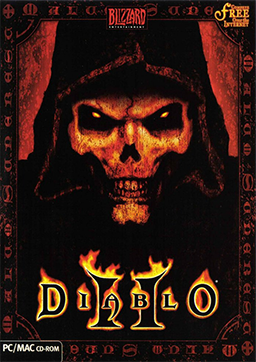
Diablo II is an action role-playing hack-and-slash video game developed by Blizzard North and published by Blizzard Entertainment in 2000 for Microsoft Windows, Classic Mac OS, and macOS. The game, with its dark fantasy and horror themes, was conceptualized and designed by David Brevik and Erich Schaefer, who, with Max Schaefer, acted as project leads on the game. The producers were Matthew Householder and Bill Roper. The game was developed over a three-year period, with a crunch time of a year and a half.

Star Fox Adventures is a 2002 action-adventure game developed by Rare and published by Nintendo. The game had a long development cycle starting in 1997. Originally developed as Dinosaur Planet with Rare-created characters as the protagonists, Nintendo producer Shigeru Miyamoto convinced Rare to redesign the game as part of the Star Fox franchise. Its planned release on the Nintendo 64 was cancelled, with development ultimately shifting forward one hardware generation to the GameCube.

BlizzCon is an annual gaming convention held by Blizzard Entertainment to promote its major franchises including Warcraft, StarCraft, Diablo, Hearthstone, Heroes of the Storm, and Overwatch.
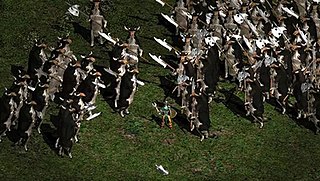
The secret cow level, or simply the cow level, is a level featured in the action role-playing hack and slash video game series Diablo, developed and published by Blizzard Entertainment. It first appears as postgame content in 2000's Diablo II, where it is officially known as the "Moo Moo Farm". Players may access the level after collecting a special combination of items to conjure a portal leading to the level. The player character is confronted upon arrival by a large horde of armed anthropomorphic cows led by a boss character called the "Cow King".
World of Warcraft, or WoW, is set in a fictional universe, its primary setting being the planet of Azeroth. The first expansion, The Burning Crusade, introduced a second planet, Outland. Wrath of the Lich King and Cataclysm expanded upon Azeroth and respectively added Northrend, the frigid northern continent of Azeroth, and drastically changed various other continents by destroying some and unveiling new ones. The next expansion, Mists of Pandaria, added Pandaria, the southern continent previously hidden behind a perennial mist cover. Warlords of Draenor introduced the planet of Draenor, a version of Outland in a different timeline before its partial destruction. The Legion expansion took adventurers to the Broken Isles, an island chain near the Maelstrom in the middle of the Great Sea, and the damaged planet Argus, the headquarters of the Burning Legion. The seventh expansion, Battle for Azeroth, added two new island continents to the center of Azeroth: Kul Tiras and Zandalar. The latest expansion, Shadowlands, introduced the eponymous Shadowlands, a realm composed of five major zones: Bastion, Maldraxxus, Ardenweald, Revendreth, and the Maw.

Diablo is an action role-playing dungeon crawler video game series developed by Blizzard North and continued by Blizzard Entertainment after the North studio shut down in 2005. The series is made up of four core games: Diablo, Diablo II, Diablo III, and Diablo IV. Expansions include the third-party published Hellfire, which follows the first game; Lord of Destruction, published by Blizzard and released after the second game; and Reaper of Souls, which follows the third game. Additional content is provided through story elements explored in other media forms.

Battle.net is an Internet-based online game, social networking service, digital distribution, and digital rights management platform developed by Blizzard Entertainment. The service was launched on December 31, 1996, followed a few days later with the release of Blizzard's action-role-playing video game Diablo on January 3, 1997. Battle.net was officially renamed to "Blizzard Battle.net" in August 2017, with the change being reverted in January 2021.

Diablo II: Lord of Destruction is an expansion pack for the hack and slash action role-playing game Diablo II. Unlike the original Diablo's expansion pack, Diablo: Hellfire, it is a first-party expansion developed by Blizzard North.

Hellfire, often called Diablo: Hellfire, is an expansion pack for the video game Diablo, developed by Synergistic Software, a Sierra division, and published by Sierra On-Line in 1997. Despite the objections of Blizzard Entertainment, the Hellfire expansion was produced, permitted by Davidson & Associates, their parent company at the time. Blizzard North, who was developing the sequel Diablo II, thus imposed numerous restrictions upon Synergistic Software's development of Hellfire.
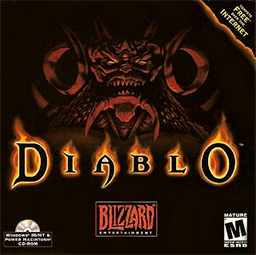
Diablo is an action role-playing video game developed by Blizzard North and released by Blizzard Entertainment in January 1997, and is the first installment in the video game series of the same name.
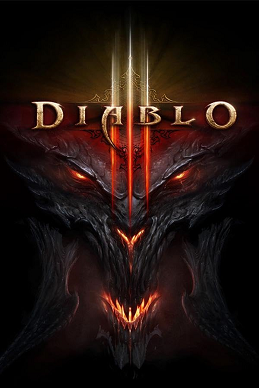
Diablo III is a 2012 online-only hack-and-slash action role-playing game developed and published by Blizzard Entertainment as the third installment in the Diablo franchise. It was released for Microsoft Windows and OS X in May 2012, PlayStation 3 and Xbox 360 in September 2013, PlayStation 4 and Xbox One in August 2014, and Nintendo Switch in November 2018. Set 20 years after the events of Diablo II, players control one of seven character classes – Barbarian, Crusader, Demon Hunter, Monk, Necromancer, Witch Doctor, or Wizard – and are tasked with defeating Diablo.

Heroes of the Storm is a crossover multiplayer online battle arena video game developed and published by Blizzard Entertainment. Announced at BlizzCon 2010, it was released on June 2, 2015 for macOS and Windows. The game features various characters from Blizzard's franchises as playable heroes, as well as different battlegrounds based on Warcraft, Diablo, StarCraft, and Overwatch universes.
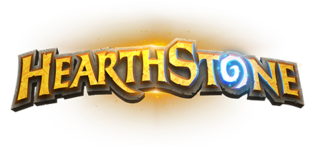
Hearthstone is a free-to-play online digital collectible card game developed and published by Blizzard Entertainment. Originally subtitled Heroes of Warcraft, Hearthstone builds upon the existing lore of the Warcraft series by using the same elements, characters, and relics. It was first released for Windows and macOS in March 2014, with ports for iOS and Android released later that year. The game features cross-platform play, allowing players on any supported device to compete with one another, restricted only by geographical region account limits.

World of Warcraft: Legion is the sixth expansion set in the massively multiplayer online role-playing game (MMORPG) World of Warcraft, following Warlords of Draenor. It was announced on August 6, 2015 at Gamescom 2015. The expansion was released on August 30, 2016.

Diablo III: Rise of the Necromancer is a downloadable content pack for the action role-playing video game Diablo III. It was announced at BlizzCon 2016. It was digitally released for the PC, Mac, and latest-generation console versions of Diablo III on June 27, 2017. It is included in the retail and digital release Diablo III: Eternal Collection for consoles. The pack adds the Necromancer class to Diablo III.

Diablo Immortal is a free-to-play, massively multiplayer online action role-playing video game developed by Blizzard Entertainment and NetEase. A mobile game in the Diablo series, it is set between the events of Diablo II and Diablo III. Players control a character of their chosen class: Barbarian, Wizard, Monk, Necromancer, Demon Hunter, Crusader, or Blood Knight; they must locate and destroy hidden shards of the Worldstone, to prevent Skarn, the Lord of Damnation, from destroying the world of Sanctuary.

Diablo IV is a 2023 online-only action role-playing dungeon crawling game developed and published by Blizzard Entertainment. It is the fourth main installment in the Diablo series. Announced at BlizzCon 2019, the game was released on June 5, 2023 for the PlayStation 4 and PlayStation 5, Xbox One and Xbox Series X and S, and Microsoft Windows. Players create a character from one of five playable classes—Barbarian, Druid, Necromancer, Rogue, or Sorcerer—and use their skills to complete quests through combat.
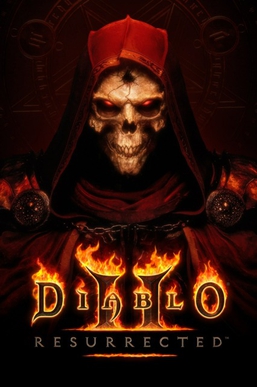
Diablo II: Resurrected is an action role-playing video game co-developed by Blizzard Entertainment and Blizzard Albany and published by Blizzard Entertainment. It is a remaster of Diablo II (2000) and its expansion Lord of Destruction (2001). The game was released for Nintendo Switch, PlayStation 4, PlayStation 5, Windows, Xbox One, and Xbox Series X and Series S on September 23, 2021.

















